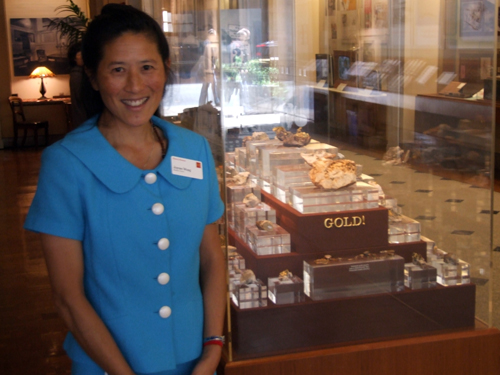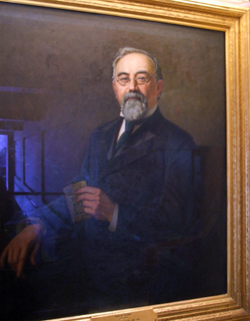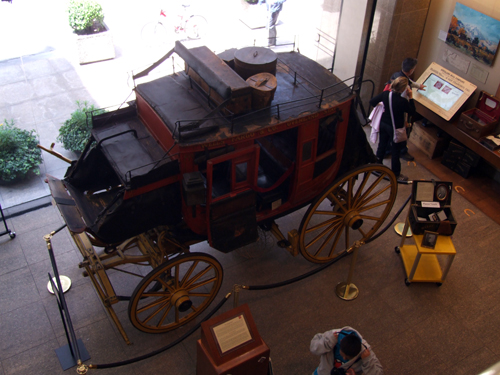By Donald H. Harrison
SAN FRANCISCO – Joycee Wong missed the fourth-grade study week in Old Town San Diego when she moved with her family from Hong Kong to Chula Vista, California. Starting her U.S. schooling in fifth grade, she didn’t have the opportunity to learn very much about California history. After going on to graduate from Bonita Vista Junior and Senior High Schools, as well as UCSD, Wong migrated north to San Francisco, pursuing a career in human resources – or personnel management. But fate has a way of playing tricks on us.
At Wells Fargo Bank’s headquarters at 420 Montgomery Street, an employment opportunity was advertised for someone to work at the company’s historical museum. Interested in learning more about California, Wong applied for and was accepted for the job. Today part of the museum’s curatorial staff, Wong expresses pride over how Wells Fargo reached out to immigrants. Even at the time of the Chinese Exclusion Act, when sentiment against Asians ran particularly high in California, she said, Wells Fargo was hiring Chinese bank clerks to better serve the Chinese community in California. She said that this was in keeping with the philosophy of founders, Henry Wells and William Fargo, who gave strict orders to company employees never to discriminate against people, no matter what their color or national background. If the company were to serve the community, it had to show respect for its customers.

According to Wong, Wells Fargo understood the importance and desirability of “diversity” long before that word became part of the business lexicon. In 1905, Isaias W. Hellman, who had come to America as a nearly penniless Jewish immigrant, was named to the presidency of Wells Fargo, ushering in three generations of Hellman family management of the growing bank.
Hellman, who had started his business career with a dry goods store in Los Angeles, got into banking almost by accident. Customers had no place to keep their gold (which was more popular than paper currency but more difficult to carry around) and Hellman allowed them to store it in the safe of his store. From this developed the ability to use some of this gold for the purpose of making loans – and eventually Hellman helped to found the Farmers Merchant Bank and the Nevada National Bank. The latter merged with Wells Fargo, which was then controlled by Ed Harriman, and with the merger Hellman became the president in 1905.

Just a year later came the great California earthquake, and although some of the bank’s buildings were destroyed, its vault was not and Wells Fargo remained open for business, which for a time Hellman transacted out of his home. Wong said that some 75 years ago, Wells Fargo recognized that people were interested in learning more about California Gold Rush days, California gold mining, the Wells Fargo Express stagecoaches, and the development of financial institutions throughout California and the West.
Originally, Wells Fargo’s history display was located in another of its San Francisco buildings, but eventually, the display was moved and enlarged at the company’s downtown headquarters. Here fourth graders in particular come to learn their California history – taking a tour that is in far greater depth and with more historical artifacts – than fourth graders and other visitors see at the Wells Fargo Museum in Old Town San Diego.
Real gold, kept under the watchful eyes of museum staff, is displayed in a hard plastic case. As in San Diego, there is a Wells Fargo stagecoach, but in San Francisco there is also a stagecoach body into which visitors may climb and get the feeling of what it might have been like to ride on rough roads across the country.
To help visitors visualize the trip, moving scenery is projected against an interior window, with the sound of horses’ hooves adding to the feeling of the journey. The exhibit also includes examples of messages—and the cost of sending them —from people across the country. There also is a documentary depicting the company’s history, particularly at the time of the great San Francisco Earthquake.
Free to the public, the museum is, of course, a public relations opportunity for Wells Fargo. However, for children and adults, it is also quite interesting. Wong removed from a pouch a $20 gold piece from 1877. Its value today fluctuates with the price of gold but is in excess of $1,000, according to Wong. On the day we chatted, gold was being sold for approximately $1,600 an ounce. At the time of its minting, the gold piece was worth somewhere between $16 and $20 an ounce – or approximately enough in those days to buy a pistol.
*
Harrison is editor of San Diego Jewish World. He may be contacted at donald.harrison@sdjewishworld.com File: US Canada West 10
